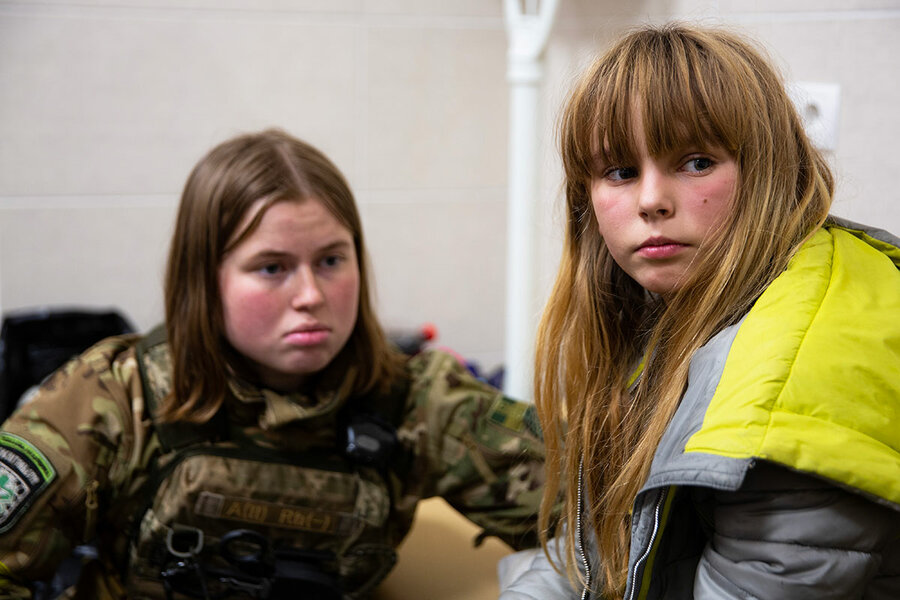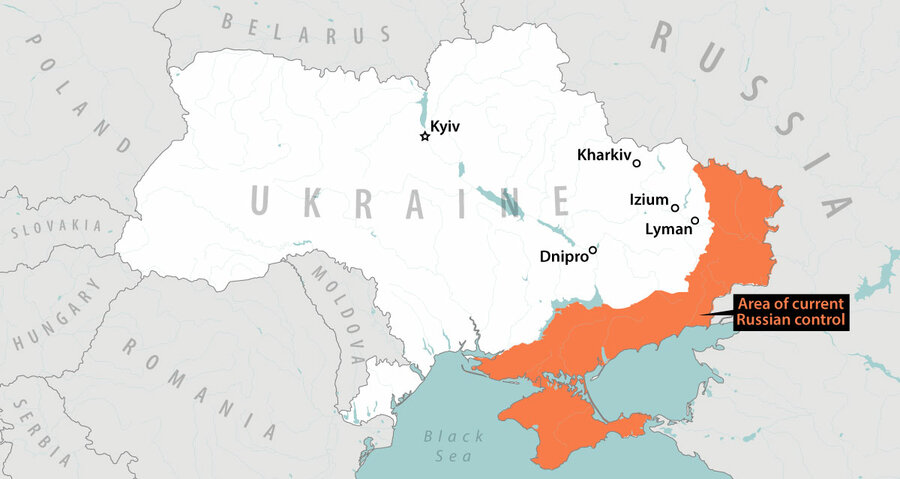Protecting kids in Ukraine: Three tales of courage and care
Loading...
| Lyman, Dnipro, and Izium, Ukraine
Since day one of the war in Ukraine, protecting children has been a struggle.
There have been the children who watched their parents die, such as Andriy and Olha, two youngsters who survived the explosion of a Russian artillery shell in their village in eastern Ukraine, but whose father didn’t.
Why We Wrote This
A story focused onChildren always fall victim to war. In Ukraine, networks of foster parents, charity workers, and combat medics are caring for young physical and psychological casualties.
There have been the children who themselves have been killed – over 400, according to official figures, and 850 injured.
Then there are the kids – around 100,000 of them – who have had to leave the institutions such as social care boarding schools, many of which closed when the war began. Some are orphans, some have disabilities, and others come from troubled families. Ukraine held the largest number of children in institutional care in Europe before the war.
What has happened to them all since then is unclear: UNICEF said in September that it was still trying to trace 26,000 missing minors.
And then there are also the children who have gone to Russia – either voluntarily, with their parents’ consent, for spells in summer camp, or were abducted, according to Ukrainian government allegations. Some have come home, often when their parents went to find them. Some have not – and their whereabouts are unknown.
It was shrapnel that made orphans of Andriy and Olha.
The Russian shell landed outside their home as a battle between Ukrainian and Russian forces pummeled their village of Torske in eastern Ukraine. The brother and sister were inside their two-story house; their father, a single dad, was outside in the garden.
“They saw the moment their father was killed,” says combat medic Nika Cherniavska, who helped rescue them. She had bonded with the children over several previous visits to their house, attempting to persuade them to leave. “They saw everything.”
Why We Wrote This
A story focused onChildren always fall victim to war. In Ukraine, networks of foster parents, charity workers, and combat medics are caring for young physical and psychological casualties.
Just hours after the attack, in the nearby town of Lyman, the siblings sit in traumatized silence in a minivan, awaiting evacuation to a hospital. Olha stares into space. Andriy is lost for words until he remembers something crucial: his prized collection of military patches. Ms. Cherniavska grasps their emotional value and asks where he kept them. When the children are driven off to the nearest city, Kramatorsk, she returns to Torske in search of the insignias.
Protecting children has been a struggle since day one of the war in Ukraine. From families like that of Andriy and Olha caught in the crossfire, to the tens of thousands of children who lived in state-run boarding facilities before the war, Ukraine’s children are seeing their support systems stripped away while facing mortal danger. It is a challenge that foster parents, child charity workers, and combat medics like Ms. Cherniavska confront with courage.
Indeed, Ms. Cherniavska nearly cut her own life short going back for Andriy’s patch collection: A shell landed just a few yards away from her as she did so. But the risk feels worth it when she returns to the hospital. The badges bring immediate comfort to Andriy who lays them out on a hospital bed.
“I thought it was irrational for me to die getting the kid’s badges,” says Ms. Cherniavska, but “it was perhaps the only thing that could make him feel someone cares.”
For Olha, Ms. Cherniavska’s familiar face and warm embrace matter more. The girl had crumpled, and refused to move, when a nurse tried to take her to another room for food. “I don’t want to go to an orphanage,” she wailed.
“Big chaos”
Official figures suggest that over 400 children have been killed and 850 wounded since Russia invaded its neighbor.
Another 3,000 have been left without parental care for one reason or another, while about 100,000 minors have had to leave the institutions, such as internat boarding schools, many of which closed when the war began. With 702 boarding institutions as of early 2022, Ukraine held the largest number of children in institutional care in Europe before the war.
One in 10 were orphans, mostly teenagers, groups of siblings – whom the authorities tried to keep together – and children with disabilities who were hard to place in foster care. Others hailed from poor households or from families whose adults had been deprived of their parental rights – serving prison terms, struggling with substance use disorder, or prone to domestic violence.
When the war began, orphans in regions at risk from fighting were relocated to safer institutions in Ukraine and abroad. Most minors in institutional care were sent home to families ill-equipped to care for them. What happened to those children is not always clear. UNICEF said in September that it was still trying to trace 26,000 missing minors.
Dmytro Malashko helped coordinate evacuations in the Kyiv region as Russian forces encircled the capital last March. “It was big chaos,” he says. “It was decisions, decisions, decisions, decisions. I was on the phone all the time. Sometimes on two phones at the time.”
His foster son, Pasha, helped evacuate 20 residents from a children’s home in a suburb-turned-conflict-zone. “At the checkpoint, the soldiers would ask the children, ‘Do you know him?’ ‘Yes, yes, yes,’ they answered,” recounts Pasha. “I didn’t even know their names.” But he did know that he had to use the password “Ivanov” to get the children on a train carriage that had been specially designated by social services to shuttle orphans from Kyiv to Poland.
Last May, Maksym Nudga, who works for an organization helping youths coming out of the internat system, got a call from social services. Could he take in three teens who had just arrived in Dnipro, they wondered? He did not hesitate. But he did insist on meeting the teens first and laying down the law: no alcohol, no drugs, keep your room tidy, do your own dishes and laundry.
Ruslan Zuenko, Oleksii Visiagin, and his younger brother Sasha Visiagin agreed to those terms. They had been living in a sports-oriented internat in Lysychansk, a city in eastern Ukraine that came under fire as Russian troops advanced.
“We tried to stay put for as long as we could,” even though the school had closed, recounts Oleksii, who wears a black hoodie proclaiming his love for wrestling. “But we were going crazy from doing nothing. We couldn’t do sports. The gym wasn’t working.”
The three friends moved to Mr. Zuenko’s home, but the fighting grew more intense. “There was no gas, water, or electricity, so we just had to leave,” says Ruslan, who lost his mother years ago and has no immediate plans to join his father, who fled to Kyiv without him.
Lysychansk fell to Russian forces just weeks after the boys left. Now they share a room in a house run by Mr. Nudga’s charity, wrestling together for fun.
“A lot of the problems for children who attend internats start after they leave,” says Mr. Nudga. “They lack social and financial skills. There is a high risk of alcohol and drug abuse, and criminality. For the girls, the risks are prostitution or a high number of sexual partners, which results in early pregnancy. As a result, the girls are giving the children to orphanages or they are taken from them [by social services], so the system just goes in circles.”
Caught on the wrong side of the front line
Shifting front lines makes it hard to stay safe, as Liudmila Khazai, an accountant, knows only too well.
She was caring for three youngsters when Russian troops took over her city of Izium in April: 17-year-old Rostyslav and 16-year-old Zhenia, orphans whom she was fostering, and her 10-year-old biological son, Kyrylo.
“From March to May we were sleeping in the basement,” Ms. Khazai recalls, pointing out the bomb craters and the rocket remains scarring her neighborhood. “It was never quiet here. That’s why we sent [two of] the children to summer camp in Russia. They needed rest.”
Before the war, summer camp in Russia had been a regular part of life for many Ukrainian children in Izium, but with Russian troops occupying her city, Ms. Khazai was hesitant. “It is very hard to let your child go when there is a war,” she points out. But her children needed some proper sleep, decent food, and the chance to have some fun. The fact that other youths had gone to Russia for three-week camps in June, and returned, reassured her.
So, reluctantly, she signed them up at the Russian-run local department of education. “They didn’t want to give too much information for security reasons,” Ms. Khazai remembers. “We only knew that they would be going to a region in the Black Sea.”
Zhenia and Kyrylo went off to Russia on Aug. 27. Three weeks later, Ukrainian forces recaptured Izium; Zhenia, Kyrylo, and about 50 other local children found themselves on the wrong side of the front line.
Ms. Khazai and her fellow parents overcame their panic and banded together. With the help of Ukraine’s Ministry for Reintegration of the Temporarily Occupied Territories, they set about tracing the children and devised a complex plan to get them back, including crowdfunding the costs of their journeys to Russia.
Those journeys took them all the way across Ukraine to its western border, into Poland and through Belarus to Russia, then back again.
“There were no obstacles from the other side,” says Ms. Khazai of the Russians. “It was fine for them there, but they wanted to get back home. Home is best.”
Oleksandr Naselenko supported reporting for this article.













